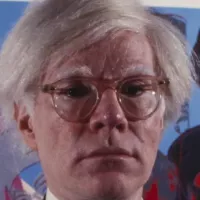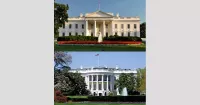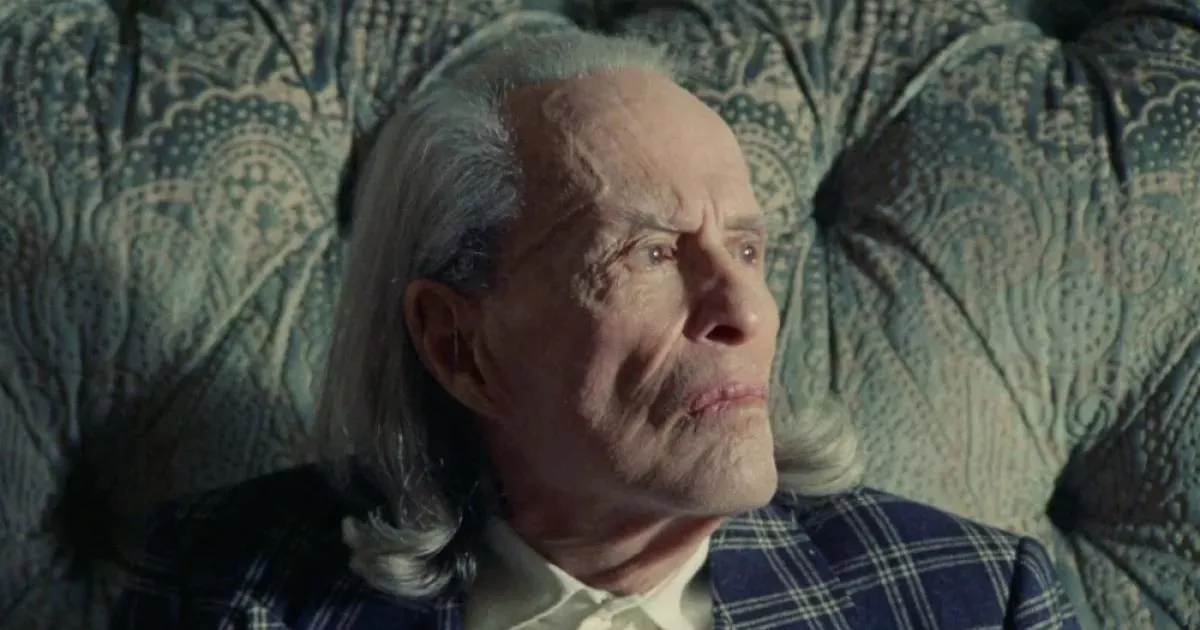Kenneth Anger was an influential American experimental filmmaker known for his short films, particularly the "Magick Lantern Cycle." His work blends surrealism, homoeroticism, and occult themes, often incorporating elements of erotica, documentary, and psychodrama. As one of America's first openly gay filmmakers, Anger's films challenged social norms and explored sexuality before its widespread acceptance. His fascination with Aleister Crowley and Thelema deeply influenced his cinematic style and subject matter.
1918: Jean Anglemyer Born
In 1918, Jean Anglemyer, Kenneth Anger's older sister, was born. She was the first child of Wilbur and Lillian Anglemyer.
1921: Robert Anglemyer Born
In 1921, Robert "Bob" Anglemyer, Kenneth Anger's older brother, was born. He was the second child of Wilbur and Lillian Anglemyer.
February 3, 1927: Kenneth Anger Born
On February 3, 1927, Kenneth Anger, originally named Kenneth Wilbur Anglemyer, was born. He later became an American underground experimental filmmaker, actor, and writer.
1927: Birth of Kenneth Anger
In 1927, Kenneth Anger was born as Kenneth Wilbur Anglemyer. He grew up in a Presbyterian family and later became interested in the occult.
1937: First Film
In 1937, Kenneth Anger started working on films. That year he created his first short film, marking the beginning of his career as a filmmaker.
1937: Ferdinand the Bull
In 1937, at age ten, Anger created his first film, "Ferdinand the Bull", using leftover 16mm film from family vacations.
1941: Who Has Been Rocking My Dreamboat
In 1941, Anger created "Who Has Been Rocking My Dreamboat," which he often called his first proper film, at the age of 14.
1944: Move to Hollywood and School
In 1944, the Anglemyer family moved to Hollywood, and Kenneth began attending Beverly Hills High School.
1947: Fireworks Created
In 1947, Kenneth Anger created the short film "Fireworks", dealing with his sexuality.
1948: Fireworks Exhibited Publicly
In 1948, the film "Fireworks" was exhibited publicly, marking a significant moment in Anger's career and his exploration of controversial themes.
1949: Puce Women and The Love That Whirls
In 1949, Anger started work on "Puce Women" and directed "The Love That Whirls", but the latter was destroyed due to its obscene content.
1949: Fireworks Shown at Festival du Film Maudit
In 1949, Fireworks was shown at Festival du Film Maudit in Biarritz.
1950: Move to Paris
In 1950, Kenneth Anger moved to Paris, France, and befriended Jean Cocteau, who inspired and supported his filmmaking endeavors.
1953: Eaux d'Artifice
In 1953, Anger produced the short film "Eaux d'Artifice," inspired by the European avant-garde scene, marking a shift in his artistic direction.
1953: Mother's Death and Return to U.S.
In 1953, Anger's mother died, prompting his return to the U.S. to handle her estate and reconnect with the California artistic scene.
1954: Inauguration of the Pleasure Dome Created
In 1954, Anger created "Inauguration of the Pleasure Dome," a surrealist film featuring Thelemite themes.
1955: Filming Thelema Abbey documentary
In 1955, Kenneth Anger and Alfred Kinsey traveled to Cefalù, Sicily, to film a documentary titled Thelema Abbey. The documentary, which was made for British television, documented Anger restoring wall paintings and performing Crowleyan rituals at the Abbey of Thelema.
1958: Inauguration of the Pleasure Dome Screened
In 1958, Anger exhibited "Inauguration of the Pleasure Dome" at various European film festivals and Expo 58, gaining recognition.
1961: Return to the U.S. and Work on Scorpio Rising
In 1961, Kenneth Anger returned to the U.S. and began working on Scorpio Rising, a film exploring the biker subculture with controversial visuals and a soundtrack of popular 1960s songs.
1963: Scorpio Rising released
In 1963, Kenneth Anger released Scorpio Rising, a film featuring homoerotic imagery and starring a muscled, topless, leather-clad biker.
1964: Scorpio Rising
In 1964, Anger released "Scorpio Rising", a film known for its blending of surrealism and homoeroticism.
1965: Kustom Kar Kommandos and Hollywood Babylon
In 1965, Anger released "Kustom Kar Kommandos" and the gossip book "Hollywood Babylon". The latter became infamous for its sensational claims.
1965: Kustom Kar Kommandos released
In 1965, Kenneth Anger released Kustom Kar Kommandos, featuring homoerotic imagery of a young man sensually polishing a car.
1965: Pirated version of Hollywood Babylon released in the U.S.
In 1965, a pirated and incomplete version of Kenneth Anger's book, Hollywood Babylon, was printed in the U.S. The book, co-written with Elliott Stein, was filled with celebrity gossip and scandalous stories.
1966: Anger on Fireworks
In 1966, Anger provided a statement about his film "Fireworks", reflecting on its themes and personal significance.
1966: Move to the William Westerfeld House and planning Lucifer Rising
In 1966, Kenneth Anger moved into the William Westerfeld House in San Francisco and began planning his film Lucifer Rising, based on Thelemite beliefs. He searched for someone to play Lucifer and met Bobby Beausoleil.
1966: Release of Sacred Mushroom Edition of Inauguration of the Pleasure Dome
In 1966, Kenneth Anger released the "Sacred Mushroom Edition" of Inauguration of the Pleasure Dome, screened to people taking LSD to enhance their sensory experience. Also in 1966, Anger became well known in the American underground scene.
October 26, 1967: "Death" of Kenneth Anger
On October 26, 1967, Kenneth Anger publicly reinvented himself by placing an ad in The Village Voice declaring, "In Memoriam. Kenneth Anger. Filmmaker 1947–1967".
1967: Burning Previous Works
In 1967, Anger burned much of his previous film work, marking a significant moment in his artistic development.
1967: Dispute with Beausoleil and Allegations of Stolen Footage
In 1967, Kenneth Anger accused Bobby Beausoleil of stealing footage from Lucifer Rising, leading to a falling out. Beausoleil denied the theft and later became involved with Charles Manson and the Manson Family.
1969: Invocation of My Demon Brother
In 1969, Anger involved countercultural figures in "Invocation of My Demon Brother", exploring Thelema-themed works.
1970: Rabbit's Moon Completed
In 1970, Anger retrieved footage and finally completed and released the film Rabbit's Moon.
1971: Rabbit's Moon Release
In 1971, Kenneth Anger released the short film "Rabbit's Moon", further exploring avant-garde themes.
1972: Lucifer Rising
In 1972, Anger produced "Lucifer Rising", continuing his exploration of occult themes.
1972: Release of Rabbit's Moon
In 1972, Kenneth Anger released the footage he had filmed for Rabbit's Moon in the 1950s.
1974: Official U.S. publication of Hollywood Babylon
In 1974, the official American version of Kenneth Anger's Hollywood Babylon was published. Following its release, Gloria Swanson filed a lawsuit against Anger, to which he responded by sending a sugar-filled coffin.
1979: Replacement of Page's music on Lucifer Rising
In 1979, Jimmy Page's music was removed from Lucifer Rising and replaced with music written and recorded by Bobby Beausoleil. This was due to a falling out with Page and his partner, Charlotte.
1979: Re-release of Rabbit's Moon and Puce Moment
In 1979, Kenneth Anger re-released a shorter version of Rabbit's Moon and added a new soundtrack to Puce Moment before rereleasing it.
1980: Paint Thrown on Warhol's Door
In 1980, Kenneth Anger threw paint on the front door of a house Andy Warhol had recently moved out of, which was a reaction to Warhol's success in the art world and underground film scene.
1981: Release of Lucifer Rising
In 1981, Kenneth Anger released Lucifer Rising, a 30-minute film based on Thelemite concepts, featuring occult symbolism and starring Miriam Gibril, Donald Cammell, Marianne Faithfull, and Leslie Huggins.
1984: Hollywood Babylon II
In 1984, Anger focused on "Hollywood Babylon II" after struggling to produce a sequel to Lucifer Rising.
1984: Incident on Coca Crystal's Television Show
In 1984, Kenneth Anger was invited to appear on Coca Crystal's television show. He allegedly attacked talent coordinator Maureen Ivice after his demand to have his taxi fare paid was refused.
1986: Video Rights Sold
In 1986, Kenneth Anger sold the video rights to his films, allowing them to be released on VHS and gain greater publicity.
1991: Move to Palm Springs
In 1991, Kenneth Anger moved to West Arenas Boulevard in Palm Springs, California, living in what was formerly the estate of his friend Ruby Keeler.
1993: Visit to Sydney
In 1993, Kenneth Anger visited Sydney, lectured at a season of his films at the Australian Film Institute Cinema, and worked on a final treatment for a feature film about Rosaleen Norton.
1995: Anger Acknowledged
In 1995, Bill Landis, Anger's unofficial biographer, remarked that the Changeling Prince visually resembled Anger as a child.
1995: Publication of Unofficial Biography
In 1995, Bill Landis, wrote an unofficial biography of Kenneth Anger, which Anger condemned.
2000: Screening of Don't Smoke That Cigarette
In 2000, Kenneth Anger began screening a new short film, the anti-smoking Don't Smoke That Cigarette.
2004: Screening of Anger Sees Red and Patriotic Penis
In 2004, Kenneth Anger began showing two short surrealistic films: Anger Sees Red, starring himself, and Patriotic Penis.
2004: Anger Sees Red released
In 2004, Kenneth Anger released Anger Sees Red, which includes imagery of a muscled, topless man performing press-ups.
2008: Appearance in FLicKeR
In 2008, Kenneth Anger made an appearance in Nik Sheehan's feature documentary about Brion Gysin and the Dreamachine, FLicKeR.
2009: Appearance in Night of Pan
In 2009, Kenneth Anger appeared alongside Vincent Gallo in the short film Night of Pan. His work was featured in a retrospective exhibition at the MoMA PS1 in New York City in the same year.
2010: Anger explains name condensation
In a 2010 interview, Kenneth Anger explained that he condensed his name from Anglemyer to Anger as a memorable logo.
2015: Hollywood Babylon III withheld due to Tom Cruise section
In 2015, Kenneth Anger finished writing Hollywood Babylon III but withheld it from publication, citing concerns about potential legal action from Tom Cruise and the Church of Scientology due to a critical section about them.
2019: Subject of documentary 'Cinemagician'
In 2019, Kenneth Anger became the subject of 'Cinemagician - Conversations with Kenneth Anger,' a documentary short by Carl Abrahamsson featuring some of his last recorded interviews.
May 11, 2023: Kenneth Anger Death
On May 11, 2023, Kenneth Anger passed away. He was an influential figure in experimental filmmaking.
2023: Beausoleil serving life sentence
As of 2023, Bobby Beausoleil is serving a life sentence for the murder of Gary Hinman.
Mentioned in this timeline
California is a U S state on the Pacific Coast...

Tom Cruise is a highly successful American actor and producer...

Andy Warhol - was a pivotal American artist film director...

San Francisco is a major commercial financial and cultural hub...

Fireworks are pyrotechnic devices primarily utilized for entertainment and aesthetic...
Sicily the largest and most populous Mediterranean island is an...
Trending

5 months ago Josh Allen and Hailee Steinfeld Wedding Soon: Bills QB Shows No Jitters

9 days ago Ben Shelton faces Kamil Majchrzak at ATP Basel after Rune's setback: Predictions.

1 hour ago Tyler Perry Criticized for Church Act Amidst Donation Shaming Controversy
1 hour ago Navy Federal Credit Union Expands with New Mayfield Heights Branch: Services Enhanced

2 hours ago Jim Irsay's collection of guitars and artifacts to be sold at auction.

2 hours ago Parker McCollum's 'What Kinda Man' Hellcat Challenger Listed for Sale at $98,900.
Popular

Gavin Newsom is an American politician and businessman currently serving...

The White House located at Pennsylvania Avenue NW in Washington...

Doug Ford is a Canadian politician and businessman currently serving...

George Soros is a Hungarian-American investor and philanthropist with a...

XXXTentacion born Jahseh Dwayne Ricardo Onfroy was a controversial yet...

Candace Owens is an American political commentator and author known...
